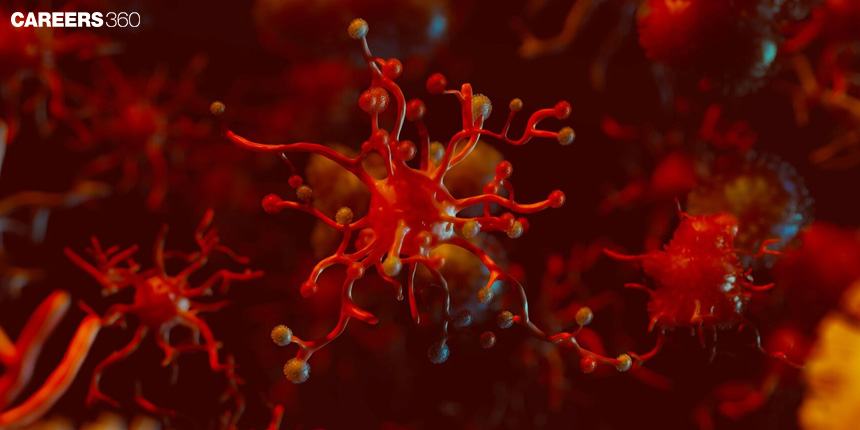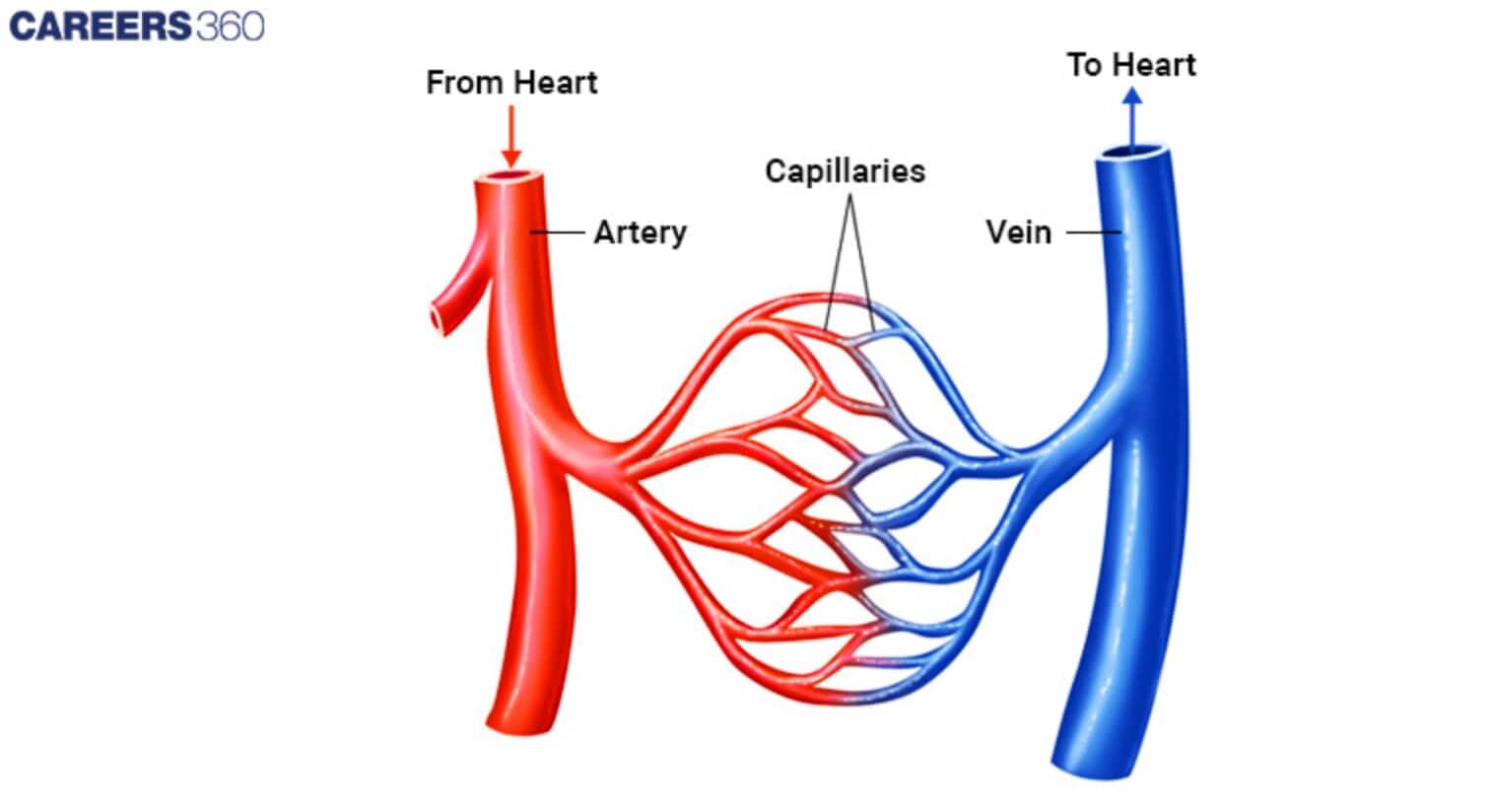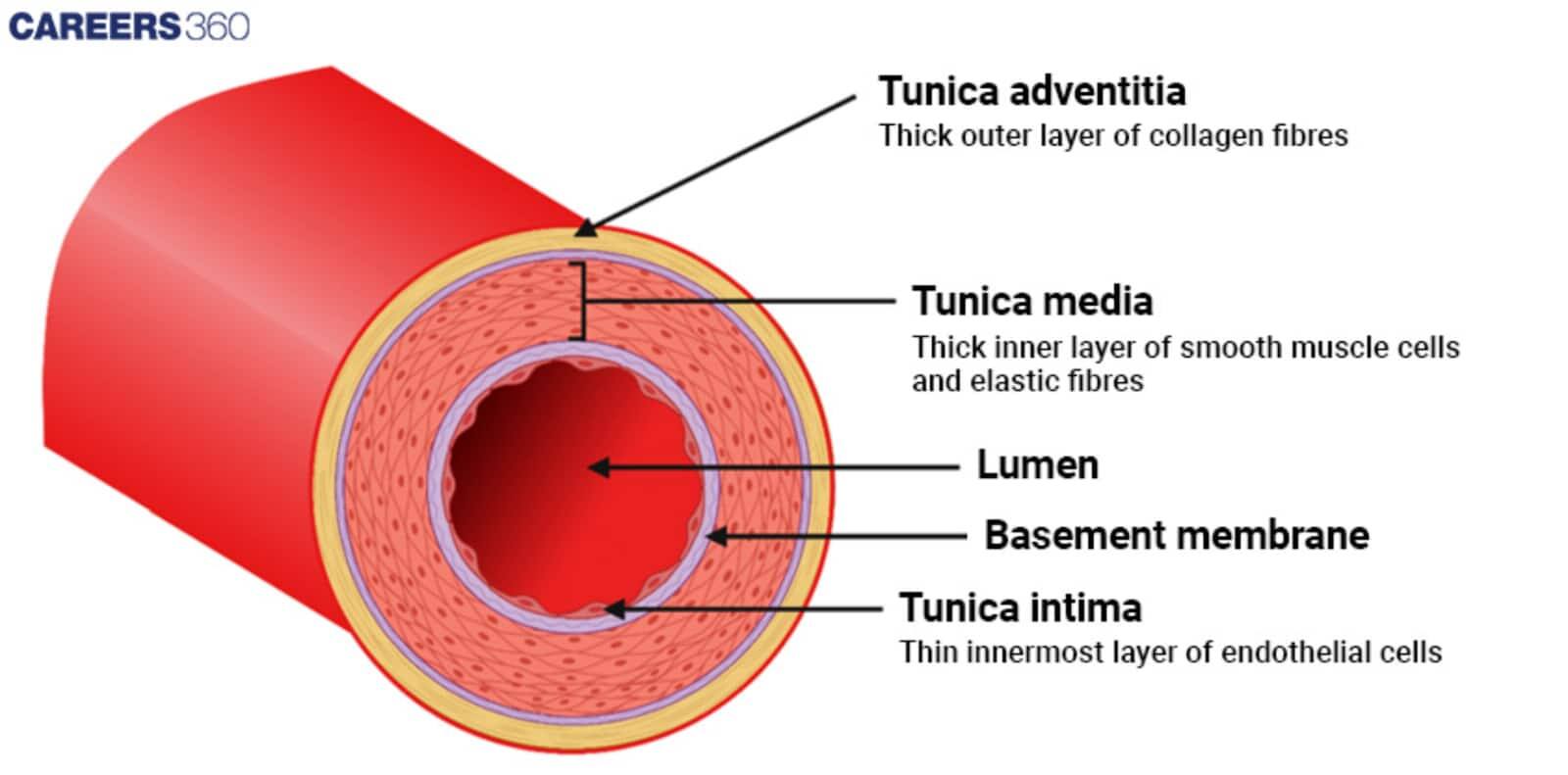What are Blood vessels?
Blood vessels are the tubular structures that carry blood throughout the body. They are important for circulation. They are categorized into three major types: arteries, veins, and capillaries. Arteries are thick-walled blood vessels which carry oxygen-rich blood away from the heart to the tissues. The three layers of blood vessels are tunica intima, tunica media, and tunica externa, which provide strength and flexibility with the control of blood flow. The main role, therefore, is to facilitate the transportation of oxygen, nutrients, and hormones while removing waste products, and even maintaining homeostasis. This is one of the basic topics from the Body Fluids and Circulation chapter of Biology.
NEET 2025: Mock Test Series | Syllabus | High Scoring Topics | PYQs
NEET Important PYQ's Subject wise: Physics | Chemistry | Biology
New: Meet Careers360 B.Tech/NEET Experts in your City | Book your Seat now
- What are Blood Vessels?
- Types of Blood Vessels
- Structure of Blood Vessels
- The Function of Blood Vessels
- Blood Vessel Disorders

What are Blood Vessels?
Blood vessels are complex tubular structures designed to carry blood in the bodies of living organisms and are key components of the circulatory system. Examples include the artery, which supplies oxygen-rich blood to the various organs in the body the vein, which supplies oxygen-poor blood back to the heart and the capillary, which acts as a connection between the artery and vein supplying blood to tissues and removes waste products from the body. Blood vessels uphold the homeostasis of the body and organs, bring nutrients in as well as take off unwanted substances and wastes.
Also Read
Types of Blood Vessels
The different types of blood vessels are:
Arteries
Arterial walls are thick, muscular and elastic and they consist of three tunics namely tunica intima, tunica media and tunica externa.
All of them transport oxygen-rich blood from the heart to different organs of the body, except pulmonary arteries that transport oxygen-poor blood to the lungs.
The aorta is the largest artery that splits into blood vessels of smaller sizes as they distribute blood throughout the body.
The pulmonary arteries as the name suggests transfer deoxygenated blood from the right ventricle to the lungs.
Veins
Veins also have less elastic tissue and muscle as compared to arteries and their walls are less thick.
They have flaps that seal off to avoid backflow of the blood to other areas other than the heart.
Veins also transport blood that is back to the heart, although not fully oxygenated, except the pulmonary veins which transport fully oxygenated blood from the lungs to the heart.
Superior and Inferior vena cava are the largest veins which carry deoxygenated blood from different parts of the body and empties into the right atrium.
Pulmonary veins transport blood high in oxygen back to the left atrium from the lungs.
Capillaries
Capillaries are the smallest types of blood vessels characterised by thin walls composed of the endothelial layer only.
This structure makes for convenient gas exchange as well as transportation of nutrients between the blood and the tissues.
They allow oxygen, carbon dioxide, nutrients and waste products that circulate in the blood to diffuse to body cells and vice versa through the process of diffusion.
Diagrams of capillary networks

Structure of Blood Vessels
Blood vessels are made up of three main layers, and generally, arteries, veins, and capillaries differ in thickness and the materials of their walls, which is suited to the role of each type of blood vessel in the circulation system.
This cross-sectional view of blood vessels shows various layers of the blood vessel walls namely- Tunica Intima, Tunica Media and Tunica Adventitia.
Tunica Intima
The deepest layer also known as the endothelium is a smooth, thin layer made up of a single layer of endothelial cells.
It gives a smooth surface that will not hinder the proper flow of blood, thus protecting against clot formation.
Tunica Media
It has smooth muscle cells and elastic fibres and has been described as simply being made of two layers.
This layer determines the size of the blood capillary through contraction and dilation, natural pressure and blood flow. The tunica media is thicker in arteries to absorb, maintain, and control high pressure delivered to different body tissues.
Tunica Externa (Adventitia)
The outer layer is made of connective tissue and contains collagen and elastic fibres of the body.
It gives mechanical support enclosing the blood vessel and fixes it with surrounding tissues.
This layer also consists of nervous fibres, in larger vessels there are vasa vasorum channels that usually give blood supply to the vessel wall.

The Function of Blood Vessels
Blood vessels play a crucial role in maintaining the body's overall health and function through several key functions:
Transport of Blood
Blood vessels are vessels which act like pipes through which blood is transported all over the body.
Arteries conveying O2-laden blood, deliver it to various tissues and organs and veins on the other side transport O2-starved blood back to the heart.
Small vessels or capillaries are threads-like structures which help to perform interchange between the blood and tissues.
Regulation of Blood Pressure
Blood vessels also assist in the control of pressure by altering their size as a result of contraction and relaxation of the smooth muscle layer in the vessels.
Arteries, because they contain elastic and muscular elements, regulate and control the disposition of blood circulation during the cardiac cycle.
Small blood vessels, veins and arteries are also part of pressure regulation because of their capacity for dilatation.
Exchange of Gases, Nutrients, and Waste Products
In capillaries, the walls of the blood vessels are very thin which aids a lot in the exchange of oxygen, carbon dioxide blood nutrients and waste products between the blood and the body cells.
It forms a network out of the blood vessels considered as a forward transport to allow a spread of oxygen as well as nutrients from the blood in the tissues.
Role in Homeostasis
Blood vessels also play a part in maintaining the temperature of the body and also the fluidity of the body.
They enable the regulation of heat by opening up more blood vessels on the skin to release heat and ensure that body fluids do not accumulate in the tissues.
Blood Vessel Disorders
Some common blood vessel disorders are:
Atherosclerosis
Atherosclerosis is characterised by the development of fatty deposits including cholesterol and other elements on the inner lining of the arteries which makes them narrow and rigid. This decreases the blood supply to organs and can cause such deadly effects as heart attack or stroke.
It may not present early signs and therefore may be recognized with signs of angina, shortness of breath or symptoms of a stroke including sudden numbness or weakness.
Also, therapy includes changes in diet and physical activity, the use of drugs that reduce cholesterol and blood pressure levels, and in some cases surgical interventions – angioplasty and/or coronary artery bypass.
Varicose veins
Varicose veins are swollen and twisted veins mainly seen on the legs due to malfunctioning of the valves of veins and failure of the walls of the veins to reclaim back blood. Some of the known symptoms include, skin changes through the appearance of big veins at the leg surface, leg pains, leg weakness, leg swelling, leg soreness and in extreme conditions development of ulcers or bleeding.
Hypertension
Hypertension refers to the state in which the blood pressure is always higher than the normal range and this puts a lot of force on the arteries leading to diseases like heart disease, kidney failure as well and the formation of stroke.
Sometimes known as the ‘silent killer’ it may not produce any signs and symptoms, but where present may lead to headaches, dizziness and nose bleeding.
Some of the treatment steps include dietary changes (eating habits, type of foods and number of calories, reduction of sodium intake), medications including ACE inhibitors, beta-blockers, and diuretics among others, and blood pressure check-ups.
Also Read
Recommended video for "What are Blood vessels?"
Frequently Asked Questions (FAQs)
The three main types of blood vessels are:
Arteries: Transport oxygen-containing blood from the heart to the various tissues or organs in the body.
Veins: Take oxygen-poor blood back to the heart from the various parts of the body.
Capillaries: Small tubes in which interchanges of oxygen with carbon dioxide and nutrients in the blood and surrounding tissues take place.
Structure: Arteries have the muscular layer (tunica media) which provides strength, and high blood pressure and enables the layer to dilate and contract. Veins have thin walls with little and no muscle and elastic taste, and have values to allow the blood to flow in only one direction.
Function: Arteries transport oxygenated blood at a high pressure away from the heart. Veins return deoxygenated blood and do so under a lower pressure to the heart.
Capillaries are the sites where diffusion of oxygen, carbon dioxide, glucose, amino acids and elimination of carbon dioxide, urea, etc take place from/to blood. Their thin walls also ensure substances are easily diffused through the adjacent walls.
Common diseases affecting blood vessels include: Common diseases affecting blood vessels include:
Atherosclerosis: Accumulation of plaque particularly within the arteries.
Varicose Veins: Swelling of the veins, elongation and spiralling that is mostly found in the legs.
Hypertension: Including hypertension that poses a threat to the arteries in the blood vessels.
To maintain healthy blood vessels, it is important to:
- Adopt a low-fat diet containing a low amount of saturated fats as well as low sodium content.
Do physical activities daily for the sake of improving heart health.
Do not smoke and absorb no more than a moderate amount of alcohol.
Chronic stress management to prevent a worsening of any of these conditions.
Administer diseases like high blood pressure and diabetes check them from time to time and take their prescribed drugs.
Also Read
29 Nov'24 01:19 PM
27 Nov'24 07:39 PM
27 Nov'24 07:15 PM
27 Nov'24 05:11 PM
26 Nov'24 08:14 PM
26 Nov'24 06:50 PM
26 Nov'24 05:51 PM
26 Nov'24 04:44 PM
26 Nov'24 03:52 PM
26 Nov'24 02:55 PM